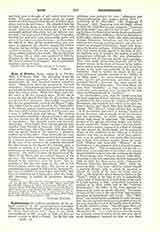

Rosicrucians, the original appellation of the alleged members of the occult-cabalistic-theosophic “Rosicrucian Brotherhood”, described in the pamphlet “Fama Fraternitatis R.C.” (Rosce crucis), which was circulated in MS. as early as 1610 and first appeared in print in 1614 at Cassel. To the first two additions were prefixed the tract “Allgemeine and Generalreformation der ganzen weiten Welt”, a translation of Fr. Boccalini’s “Del Ragguagli di Parnasso”, 1612. Beginning with the fourth edition in 1615, the third Rosicrucian rudiment, “Confessio der Fraternitat”, was added to the “Fama”. According to these, the Rosicrucian brotherhood was founded in 1408 by a German nobleman, Christian Rosenkreuz (1378-1484), formerly a monk, who while travelling through Damascus, Jerusalem, and Fez had been initiated into Arabian learning (magic), and who considered an antipapal Christianity, tinged with theosophy, his ideal of a religion. Concerned above all else that their names should appear in the Book of Life, the brothers were to consider the making of gold as unimportant—although for the true philosophers (Occultists) this was an easy matter and a parergon. They must apply themselves zealously and in the deepest secrecy to the study of Nature in her hidden forces, and to making their discoveries and inventions known to the order and profitable to the needs of humanity. And to further the object of the said order they must assemble annually at the “Edifice of the Holy Spirit“, the secret headquarters of the order, cure the sick gratuitously, and whilst each one procured himself a successor they must provide for the continuance of their order. Free from illness and pain, these “Invisibles”, as they were called in the vernacular, were supposed to be yearning for the time when the Church should be “purified”.
For two hundred years, while the world never had the least suspicion of their existence, the brotherhood transmitted by these means the wisdom of “Father” Rosenkreuz, one hundred and twenty years after the latter’s burial, until about 1604 they finally became known. The “Fama”, which effected this, invited “all of the scholars and rulers of Europe” openly to favor the cause, and eventually to sue for entrance into the fraternity, to which, nevertheless, only chosen souls would be admitted. The morbid propensity of the age for esoterism, magic, and confederacies caused the “Fama” to raise a feverish excitement in men’s minds, expressed in a flood of writings for and against the brotherhood, and in passionate efforts to win admission to the order, or at least to discover who were its members. All of these endeavors, even by scholars of real repute like Descartes and Leibniz, were without results. From the manifestly fabulous and impossible “History” of the brotherhood, it was apparent that it depended upon a “mystification”. This mystification was directly explained by an investigation of the author, who appears unquestionably to have been the Lutheran theologian of Wurtemberg, John Valentin Andrea (1586-1654). According to his own admission, Andrea composed in 1602 or 1603 the Rosicrucian book, “Chymische Hochzeit Christiani Rosenkreuz 1459”, which appeared in 1616. This book, called by Andrea himself a youthful literary trifle in which he intended to ridicule the mania of the times for occult marvels (Life, p. 10), bears the closest intrinsic relation to the “Fama”, which, in the light of this, is undoubtedly a later work of Andrea’s or at least of one of the circle of friends inspired by him. Alchemistic occultism is mocked at in these works and in the “General-Reformation“, the follies of the then untimely reformers of the world are openly ridiculed. The fantastic form of the tracts is borrowed from contemporary romances of knighthood and travel. The “Rosy Cross” was chosen for the symbol of the order because, first, the rose and cross were ancient symbols of occultism and, secondly, occur in the family arms of Andrea. It recalls Luther’s motto: “Des Christen Herz auf Rosen geht, wenn’s mitten unter’m Kreuze steht” (Hossbach, 121). As a result of his satirically meant but seriously accepted works, which soon gave rise to occult humbuggery (opposed by him) in new Rosicrucian raiment, Andrea openly renounced Rosicrucianism and frequently referred to it as a ridiculous comedy and folly. In spite of this, the Rosicrucian fraud, which served in many ways as a model for the anti-Masonic Taxil-Schwindel, has continued effective until the present day. In the seventeenth century Michael Maier and Robert Fludd were its champions. Pseudo-Rosicrucian societies arose, falsely claiming descent from the genuine fraternity of the “Fama ‘. After 1750 occult Rosicrucianism was propagated by Freemasonry, where it led to endless extravagant manifestations (St. Germain, Cagliostro, Schropfer, Wollner etc.). In the system of high degrees in “Scottish” Freemasonry, especially in the Rosenkreuz degree, the Rosicrucian symbols are still retained with a Masonic interpretation. Finally, since about 1866 there have existed in England and Scotland (London, Newcastle, York, Glasgow) and in the United States (Boston, Philadelphia) “colleges” of a Masonic Rosicrucian society, whose members claim to be direct descendants of the brotherhood founded in 1408. Only Master Masons are eligible for membership. According to the definition of the president of the London branch (Supreme Magus), Brother Dr. Wm. Wynn Westcott, M.B., P.Z., it is “the aim of the Society to afford mutual aid and encouragement in working out the great problems of life and in searching out the secrets of nature; to facilitate the study of philosophy founded upon the Kabbalah and the doctrines of Hermes Trismegistus, which was inculcated by the original Fratres Rosece Crucis of Germany, A.D. 1450; and to investigate the meaning and symbolism of all that now remains of the wisdom, art, and literature of the ancient world”. The view which has been lately revived, especially by Kitsch and Pike, that Rosicrucianism definitely or even perceptibly cooperated in the foundation of modern Freemasonry in 1717, is contradicted by well-known historical facts.
HERMANN GRUBER

